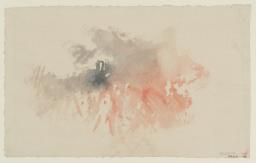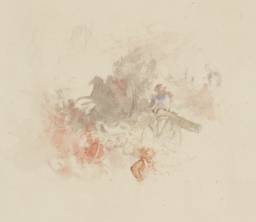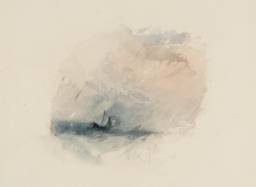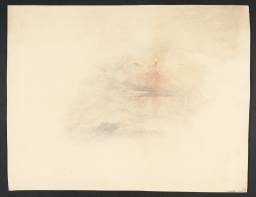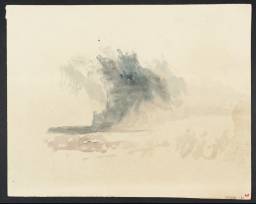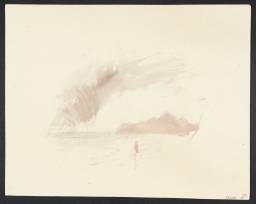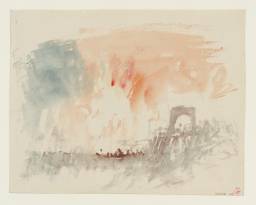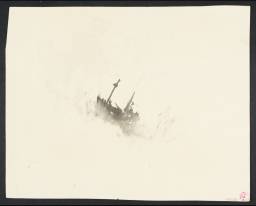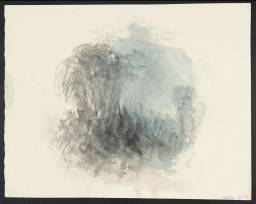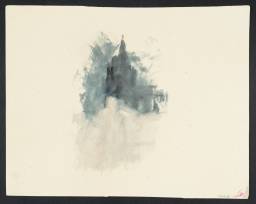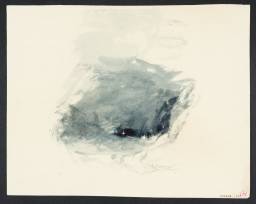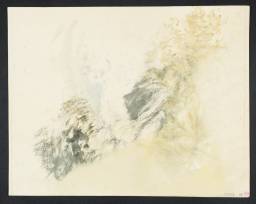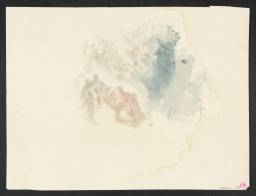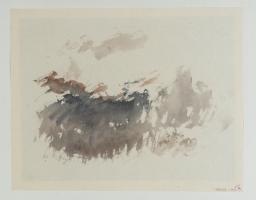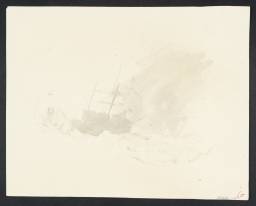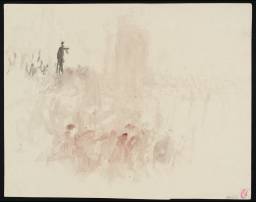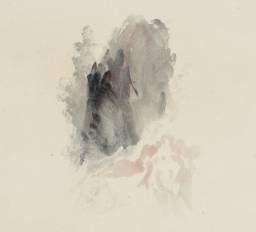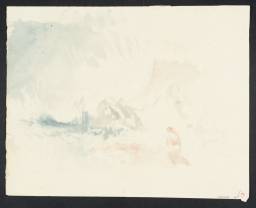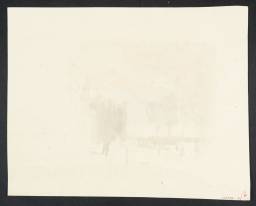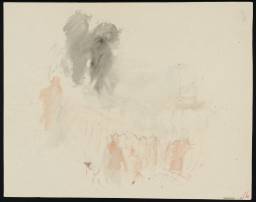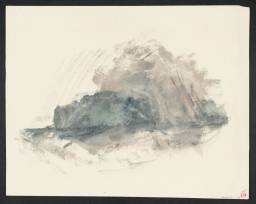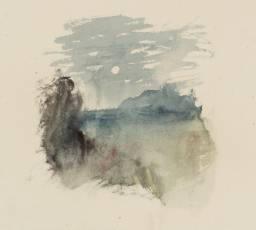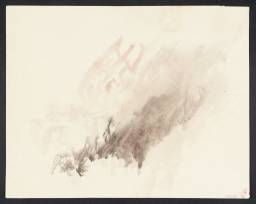Turner Bequest CCLXIII 296; CCLXXX 5; 7; 11; 39–60; 62–64; 66–72; 74–76; 86; 89; 121; 137; 209
References
Several years after finishing work on Samuel Rogers’s Italy (1830) and Poems (1834), Turner began designing another large series of vignette illustrations, this time to accompany The Poetical Works of Thomas Campbell, published by Edward Moxon in 1837. Thomas Campbell’s decision to employ Turner was undoubtedly prompted by the recent success of Rogers’s two illustrated volumes. He had the project in mind as early as 1831, when he wrote that: ‘Turner, the Painter, has promised to illustrate, with his powerful pencil, “The Pleasures of Hope”. I came to this place [Maidstone] in order to ascertain the price of paper for a new and splendid edition like Rogers’ “Italy”, at one of the papermills’.1
There are several conflicting accounts of the circumstances surrounding Campbell’s commission. However, the most reliable among them appears to be the one given by William Beattie in his Life and Letters of Thomas Campbell (1849). According to his biographer, Campbell spent well over £800 on the illustrations, paying Turner 25 guineas per design, in addition to engraver’s fees. Campbell had bought the illustrations on the assumption that he would be able to sell them for as much or more than what he had paid once the engravers were finished using them. However, he soon found that the drawings could only be sold for a fraction of their original value. Writing to a friend, Campbell happily explained how he resolved his dilemma:
One very rich and judicious amateur, to whom I offered them [the vignettes], said to me, ‘I have no intention to purchase these drawings because they are worth so little money, that I should be sorry to see you sell them for as little as they are really worth. The truth is that fifteen out of twenty are but indifferent drawings. But sell them by lottery, and either Turner’s name will bring you in two hundred guineas or Turner himself will buy them up.’ I went to Turner, and the amateur’s prediction was fulfilled, for Turner bought them up for two hundred guineas.2
A similar account appears in Walter Thornbury’s biography of Turner, this time attributed to Cyrus Redding, a friend of Campbell’s. However, Thornbury also offers another version of the exchange: after commissioning the drawings, Campbell realised that he would be unable to pay for them without incurring enormous debts. In response, Turner, ‘with kind sympathy’ simply told the poet to return the illustrations, which he later gave to a friend.3 According to yet a third story, Edward Goodall, Turner’s primary vignette engraver, signed a contract with Moxon, Campbell’s publisher, which he later realised would cause him a serious financial loss. As a result, Goodall asked Turner to cancel the commission for the drawings. The artist agreed to do so, arranging instead to loan Moxon the illustrations at a rate of £5 each.4
Beattie’s version of the story, which is supported by a letter from Campbell and echoed in Redding’s account, seems to be the closest approximation of actual events. It is not known, however, when the twenty watercolours for Campbell’s Poetical Works passed out of Turner’s hands. They are not part of the Turner Bequest and therefore had left his studio prior to the artist’s death. Their provenance can only be traced from 1896 when they were known to be in the possession of Sir Donald Currie (1805–1909), the steamship magnate.5 The vignettes passed by descent to Mrs M.D. Fergusson who, on her death in 1986, bequeathed the works to the National Gallery of Scotland where they now remain.
The Campbell vignettes are painted in an intense and wide-ranging palette and the compositions tend to be far more complex than those for Rogers’s Italy and Poems. The intensity of Turner’s images complements the dramatic content of Campbell’s poetry, which is filled with tales of star-crossed lovers, war and death. It is not known how Turner decided which subjects to illustrate, or whether Campbell participated in this process. The designs were engraved on steel by Edward Goodall, Robert Wallis, and William Miller and Poetical Works was printed in the same elegant and costly manner as Italy and Poems. The publication met with considerable success. By June 1838, the poet reported that Moxon had sold 2,500 copies of the new edition.6
The Turner Bequest contains about forty watercolour sketches that appear to be preparatory studies for the vignettes for Campbell’s Poetical Works. Thirty-two of these forty works are executed on low-grade machine-made paper and are closely related in style and technique.7 The remaining eight works also appear to be related to the series but are more varied in style and medium. Throughout the studies, Turner’s priority seems to have been to block out a general compositional structure; the addition of narrative content and visual detail did not occur except in the finished designs. Several studies, such as those for Hohenlinden, The Andes Coast and Kosciusko include elements that would reappear in the final illustrations (see Tate D27522, D27524 and D27566; Turner Bequest CCLXXX 5, 7 and 49). In most cases, however, the subjects cannot be identified with any certainty.
The studies have been divided into two groups: identified (or tentatively identified) and unidentified subjects. Studies with identified subjects are listed below, according to the order in which they would have appeared in Campbell’s text. These works are followed by studies whose subjects remain unidentified but which are nonetheless thought to relate to the same series. This assigned order disrupts the partially consecutive sequence of Tate accession numbers for studies relating to Campbell’s Poetical Works.
Identified or tentatively identified subjects:
| Tate number | Turner Bequest (Finberg) number |
| D27579 | CCLXXX 62 |
| D27524 | CCLXXX 7 |
| D27528 | CCLXXX 11 |
| D27558 | CCLXXX 41 |
| D27563 | CCLXXX 46 |
| D27568 | CCLXXX 51 |
| D27572 | CCLXXX 55 |
| D27654 | CCLXXX 137 |
| D27726 | CCLXXX 209 |
| D27562 | CCLXXX 45 |
| D27566 | CCLXXX 49 |
| D27573 | CCLXXX 56 |
| D27575 | CCLXXX 58 |
| D27576 | CCLXXX 59 |
| D27559 | CCLXXX 42 |
| D27574 | CCLXXX 57 |
| D27557 | CCLXXX 40 |
| D27638 | CCLXXX 121 |
| D27591 | CCLXXX 74 |
| D27522 | CCLXXX 5 |
| D27580 | CCLXXX 63 |
| D27581 | CCLXXX 64 |
| D27588 | CCLXXX 71 |
| D27587 | CCLXXX 70 |
| D27569 | CCLXXX 52 |
| D27592 | CCLXXX 75 |
| D27603 | CCLXXX 86 |
| D27606 | CCLXXX 89 |
Unidentified subjects:
| Tate number | Turner Bequest (Finberg) number |
| D254197 | CCLXIII 296 |
| D27556 | CCLXXX 39 |
| D27560 | CCLXXX 43 |
| D27561 | CCLXXX 44 |
| D27564 | CCLXXX 47 |
| D27565 | CCLXXX 48 |
| D27570 | CCLXXX 53 |
| D27577 | CCLXXX 60 |
| D27584 | CCLXXX 67 |
| D27586 | CCLXXX 69 |
| D27589 | CCLXXX 72 |
| D27593 | CCLXXX 76 |
| D27567 | CCLXXX 50 |
| D27571 | CCLXXX 54 |
| D27583 | CCLXXX 66 |
| D27585 | CCLXXX 68 |
The given titles largely follow those listed by Jan Piggott in his catalogue of Turner’s vignettes.8
Note: In the course of ongoing research across the Turner Bequest, in 2016 Tate D25419 (Turner Bequest CCLXIII 296) has been added as a possible Campbell subject. The text of this Introduction is otherwise unchanged.
How to cite
Meredith Gamer, ‘Watercolours Related to The Poetical Works of Thomas Campbell c.1835–6’, subset, August 2006, revised by Matthew Imms, September 2016, in David Blayney Brown (ed.), J.M.W. Turner: Sketchbooks, Drawings and Watercolours, Tate Research Publication, December 2012, https://www

